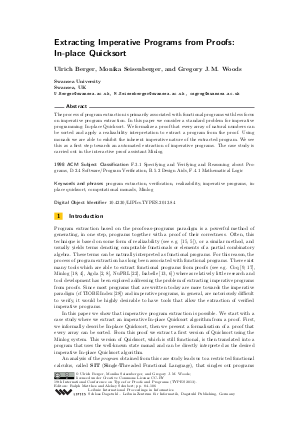Extracting Imperative Programs from Proofs: In-place Quicksort
Authors Ulrich Berger, Monika Seisenberger, Gregory J. M. Woods
-
Part of:
Volume:
19th International Conference on Types for Proofs and Programs (TYPES 2013)
Part of: Series: Leibniz International Proceedings in Informatics (LIPIcs)
Part of: Conference: International Conference on Types for Proofs and Programs (TYPES) - License:
 Creative Commons Attribution 3.0 Unported license
Creative Commons Attribution 3.0 Unported license
- Publication Date: 2014-07-25
File

PDF
LIPIcs.TYPES.2013.84.pdf
- Filesize: 0.54 MB
- 23 pages
Document Identifiers
Subject Classification
Keywords
- Program Extraction
- Verification
- Realizability
- Imperative Programs
- In-Place Quicksort,Computational Monads
- Minlog
Metrics
- Access Statistics
-
Total Accesses (updated on a weekly basis)
0Document
0Metadata
Abstract
The process of program extraction is primarily associated with functional programs with less focus on imperative program extraction. In this paper we consider a standard problem for imperative programming: In-place Quicksort. We formalize a proof that every array of natural numbers can be sorted and apply a realizability interpretation to extract a program from the proof. Using monads we are able to exhibit the inherent imperative nature of the extracted program. We see this as a first step towards an automated extraction of imperative programs. The case study is carried out in the interactive proof assistant Minlog.
Cite As Get BibTex
Ulrich Berger, Monika Seisenberger, and Gregory J. M. Woods. Extracting Imperative Programs from Proofs: In-place Quicksort. In 19th International Conference on Types for Proofs and Programs (TYPES 2013). Leibniz International Proceedings in Informatics (LIPIcs), Volume 26, pp. 84-106, Schloss Dagstuhl – Leibniz-Zentrum für Informatik (2014)
https://doi.org/10.4230/LIPIcs.TYPES.2013.84
BibTex
@InProceedings{berger_et_al:LIPIcs.TYPES.2013.84,
author = {Berger, Ulrich and Seisenberger, Monika and Woods, Gregory J. M.},
title = {{Extracting Imperative Programs from Proofs: In-place Quicksort}},
booktitle = {19th International Conference on Types for Proofs and Programs (TYPES 2013)},
pages = {84--106},
series = {Leibniz International Proceedings in Informatics (LIPIcs)},
ISBN = {978-3-939897-72-9},
ISSN = {1868-8969},
year = {2014},
volume = {26},
editor = {Matthes, Ralph and Schubert, Aleksy},
publisher = {Schloss Dagstuhl -- Leibniz-Zentrum f{\"u}r Informatik},
address = {Dagstuhl, Germany},
URL = {https://drops.dagstuhl.de/entities/document/10.4230/LIPIcs.TYPES.2013.84},
URN = {urn:nbn:de:0030-drops-46274},
doi = {10.4230/LIPIcs.TYPES.2013.84},
annote = {Keywords: Program Extraction, Verification, Realizability, Imperative Programs, In-Place Quicksort,Computational Monads, Minlog}
}
Author Details
References
-
J. R. Abrial. Modeling in Event-B: System and Software Engineering. Cambridge University Press, New York, NY, USA, 1st edition, 2010.

- Agda. URL: http://wiki.portal.chalmers.se/agda/.
-
H. Benl, U. Berger, H. Schwichtenberg, M. Seisenberger, and W. Zuber. Proof theory at work: Program development in the Minlog system. In Automated Deduction, volume II of Applied Logic Series, pages 41-71. Kluwer, 1998.

-
U. Berger, K. Miyamoto, H. Schwichtenberg, and M. Seisenberger. Minlog - A Tool for Program Extraction Supporting Algebras and Coalgebras. In A. Corradini, B. Klin, and C. Cîrstea, editors, CALCO 2011, volume 6859 of Lecture Notes in Computer Science, pages 393-399. Springer, 2011.

-
U. Berger and M. Seisenberger. Proofs, Programs, Processes. Theory of Computing Systems, 51(3):313-329, 2012.

-
S. Berghofer. Program extraction in simply-typed higher order logic. In H. Geuvers and F. Wiedijk, editors, TYPES 2002, volume 2646 of Lecture Notes in Computer Science, pages 21-38. Springer, 2003.

-
B. Brock, M. Kaufmann, and J. S. Moore. ACL2 Theorems about Commercial Microprocessors. In Formal Methods in Computer-Aided Design, volume 1166 of Lecture Notes in Computer Science, pages 275-293. Springer-Verlag, 1996.

-
C. M. Chuang. Extraction of Programs for Exact Real Number Computation Using Agda. PhD thesis, Swansea University, Wales, 2011.

- The Coq Proof Assistant. URL: http://coq.inria.fr/.
-
M. Erwig and D. Ren. Monadification of Functional Programs. Science of Computer Programming, 52(1-3):101-129, 2004.

-
S. Hallerstede and M. Leuschel. Experiments in program verification using Event-B. Formal Aspects of Computing, 24:97-125, 2012.

-
C. A. R. Hoare. Quicksort. The Computer Journal, 5(1):10-16, 1962.

- Isabelle. URL: http://isabelle.in.tum.de/.
-
S. C. Kleene. On the Interpretation of Intuitionistic Number Theory. Journal of Symbolic Logic, 10:109-124, 1945.

-
G. Kreisel. Interpretation of Analysis by means of Constructive Functionals of Finite Types. Constructivity in Mathematics, pages 101-128, 1959.

-
J. Krivine. Realizability Algebras: A Program to Well Order ℝ. Logical Methods in Computer Science, 7:1-47, 2011.

-
P. Letouzey. A New Extraction for Coq. In Types for Proofs and Programs, TYPES 2002, volume 2646 of Lecture Notes in Computer Science, pages 200-219, 2003.

- The Minlog System. URL: http://www.minlog-system.de.
-
A. Miquel. Classical Program Extraction in the Calculus of Constructions. In CSL 2007, volume 4646 of Lecture Notes in Computer Science, pages 313-327, 2007.

-
K. Miyamoto, F. Nordvall Forsberg, and H. Schwichtenberg. Program Extraction from Nested Definitions. In S. Blazy, C. Paulin-Mohring, and D. Pichardie, editors, ITP 2013, volume 7998 of Lecture Notes in Computer Science, pages 370 - 385. Springer, 2013.

-
E. Moggi. Notions of Computation and Monads. Information and Computation, 93(1):55-92, 1991.

- PRL Project. URL: http://www.nuprl.org/.
-
I. Poernomo, J. N. Crossley, and M. Wirsing. Adapting Proofs-as-Programs: The Curry-Howard Protocol. Springer, 2005.

- Swansea Minlog Repository. URL: http://cs.swan.ac.uk/minlog/.
-
D. Ratiu and T. Trifonov. Exploring the Computational Content of the Infinite Pigeonhole Principle. Journal of Logic and Computation, 22(2):329-350, 2012.

-
S. Ray and R. Sumners. Verification of an In-place Quicksort in ACL2. In D. Borrione, M. Kaufmann, and J. S. Moore, editors, 3rd International Workshop on the ACL2 Theorem Prover and Its Applications (ACL2 2002), pages 204-212, Grenoble, 2002.

-
H. Schwichtenberg and S. S. Wainer. Proofs and Computations. Perspectives in Logic. Assoc. Symb. Logic and Cambridge Univ. Press, 2012.

- TIOBE. URL: http://www.tiobe.com/index.php/content/paperinfo/tpci/index.html.
